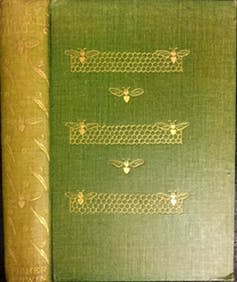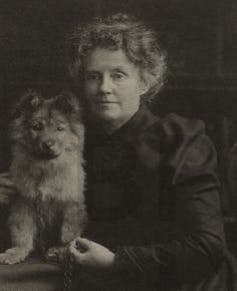Poets and lovers: the two women who were Michael Field

“Let no man think he can put asunder what God has joined”. So wrote the poet Katharine Bradley in a letter of 1886. She was explaining her relationship with her niece Edith Cooper, using the words of the Christian marriage ceremony to affirm their lifelong partnership.
In an era in which Queen Victoria is (erroneously) rumoured to have dismissed lesbianism as an impossibility, these two women declared themselves “closer married” even than Robert Browning and Elizabeth Barrett Browning – the ultimate literary power couple – because, as Bradley explained: “those two poets, man and wife, wrote alone”. Rather than writing separately, Bradley and Cooper decided to create their works as one.
They invented a whole new persona to bind them together. His name was “Michael Field”. Writing together through this male voice, Bradley and Cooper forged a collaboration that was both romantic and creative. Being Field allowed them to express things that, in Bradley’s words “the world will not tolerate from a woman’s lips”. As Field, they published hundreds of poems, many of them strikingly erotic. As they wrote defiantly in one poem:
My Love and I took hands and swore,
Against the world, to be
Poets and lovers evermore.
Bradley and Cooper certainly had reason to feel that the world was against them. Their early works were enthusiastically received: one reviewer suggested that Field be nominated for poet laureate. But once word got around that this promising writer was two women, rather than one man, their reception took a decidedly dismissive turn – precisely as they had feared.
Aesthetes and lovers
Nonetheless, the women still had the support of their friends, many of whom were part of the late-19th-century aesthetic movement. Aestheticism promoted an “art for art’s sake” philosophy, celebrating beauty as free of moral or utilitarian considerations. Aesthetic friends included Oscar Wilde, the art critic Bernard Berenson, and the artists and designers Charles Ricketts and Charles Shannon, themselves a committed same-sex couple.
Ricketts and Shannon created several beautiful volumes for Bradley and Cooper, using fine paper and stunningly intricate cover designs. Field’s works never sold in huge numbers, but they attracted an elite set of influential admirers and Bradley and Cooper became minor celebrities in the fin-de-siècle literary world.

One of their earliest volumes, Long Ago (1889) took inspiration from Sappho of Lesbos – the most celebrated woman poet of Ancient Greece and the origin of the term “lesbian”. Sappho’s poems, which only survive in fragments, address love lyrics to both male and female loved ones. Bradley and Cooper use these fragments as suggestive catalysts for their own poems, celebrating female beauty and intimacy. For example, the fragment “They plaited garlands in their time” becomes a fully-fledged vision of Sapphic community:
They plaited garlands in their time;
They knew the joy of youth’s sweet prime,
Quick breath and rapture:
Theirs was the violet-weaving bliss,
And theirs the white, wreathed brow to kiss,
Kiss, and recapture.
Love in a cold climate
Both women were deeply interested in classical literature, having studied Latin and Greek at Newnham College and University College, Bristol. The Hellenic world provided them with an example of a society in which homoerotic love was accepted and honoured. But their sexuality (including the incestuous dimension of their partnership) never appeared to trouble them much, as they proudly proclaimed their fellowship throughout their life and works.
Bradley and Cooper were true “Renaissance women”. Every new volume became an exciting new research project into which they threw themselves with gusto. No arena was off limits and their interests stretched from European art, to perfume, ecology, vegetarianism, theology and philosophy. The scope of their artistic ambition is captured in more than 20 verse dramas, as well as lyric poetry. They believed unshakably in their own genius, despite critical indifference and occasional mockery.

Perhaps their strangest volume is Whym Chow: Flame of Love, a book of poems dedicated to their beloved dog. They acquired this somewhat domineering chow in 1897 and he quickly became the centre of their world. Following his unexpected early death in 1906, the women were so devastated that they converted to Roman Catholicism, in the hopes that they would be reunited with him in heaven.
Their last volumes, Mystic Trees (1913) and Poems of Adoration (1914), contained Catholic poems that combined their earlier pagan passion with a new devotion to the Virgin Mary. Their faith offered comfort when Cooper was diagnosed with cancer in 1911. She died in 1913, with Bradley following shortly after in 1914.
Flawed icons
Michael Field was neglected for the bulk of the 20th century. But, in recent years, interest in their collaboration has grown. This raises the question: what can Bradley and Cooper teach us today? Their joint diaries have recently become available online, covering a 26-year period from 1888 to 1914.
These offer a unique insight into the ups and downs of lifelong same-sex partnership in all its complexity. Like Anne Lister’s diaries, recently dramatised as Gentleman Jack, Bradley and Cooper’s diary reveals them – potential queer icons that they were – to be deeply flawed: snobbish, over-sensitive, dismissive of women and the working classes.
As we discover their fascinating world for ourselves, they remind us that our LGBTQ historical figures can be both queer – and incorrigibly human – in truly unexpected ways.
This article is republished from The Conversation under a Creative Commons license. Read the original article.

Sarah Parker's book Michael Field: Decadent Moderns (2019) is published by Ohio University Press.

